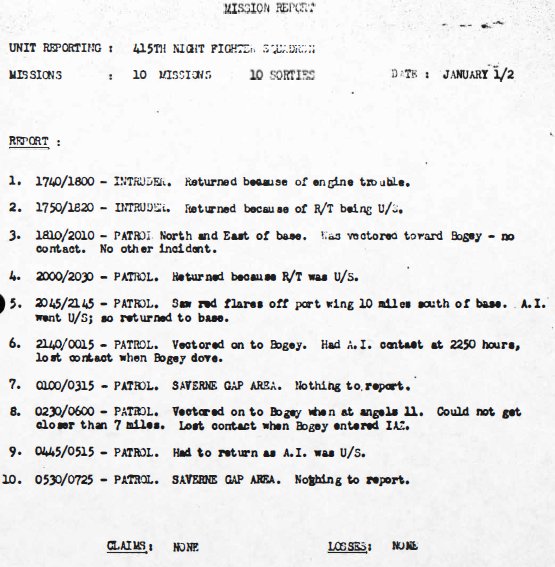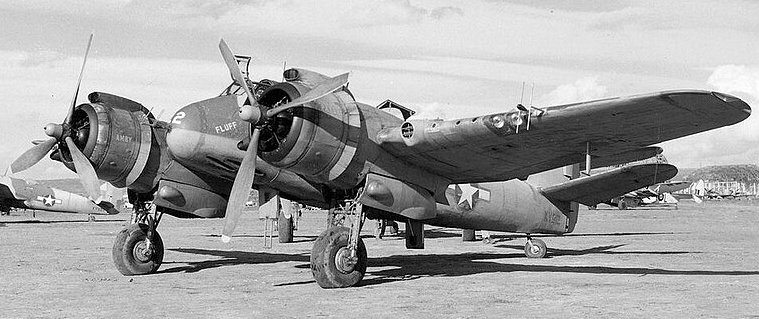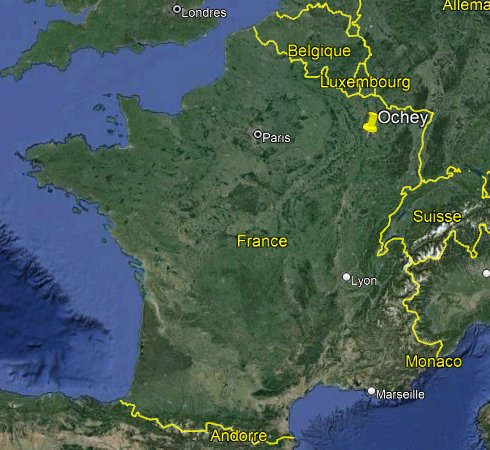ACUFO-1945-01-01-OCHEY-1
Barry Greenwood, a U.S. ufologist, leading member of the “Citizens Against UFO Secrecy” (CAUS), published in the bulletin Just Cause of this group, in September 1992, a number of mission reports of the 415th Night Fighter Squadron, from the U.S. military archive, in search for previously undocumented “Foo-Fighters” reports.
One of the reports he found said:
“January 1/2, 1945 - Mission 5 - 2045/2145 - Patrol. Saw red flares off port wing 10 miles south of base. A.I. (air intercept radar -ed.) went U/S; so returned to base.”
Barry Greenwood noted: “One frustrating feature of these reports is their brevity. It is difficult to form a hypothesis on the origin of Foo-Fighters when such fragmentary information is available. It is sometimes hard to tell whether reports of “lights” by the pilots were in the air or on the ground so one should exercise caution when reading reports where this is not clear.”
| Date: | January 1, 1945 |
|---|---|
| Time: | Between 08:45 p.m. and 09:45 p.m. |
| Duration: | ? |
| First known report date: | 1945 |
| Reporting delay: | Hours, weeks. |
| Country: | France |
|---|---|
| State/Department: | Meurthe-et-Moselle |
| City or place: | Ochey |
| Number of alleged witnesses: | 1 or 2 |
|---|---|
| Number of known witnesses: | ? |
| Number of named witnesses: | 0 |
| Reporting channel: | Military operation report. |
|---|---|
| Visibility conditions: | Night. |
| UFO observed: | Yes. |
| UFO arrival observed: | ? |
| UFO departure observed: | Yes. |
| UFO action: | |
| Witnesses action: | |
| Photographs: | No. |
| Sketch(s) by witness(es): | No. |
| Sketch(es) approved by witness(es): | No. |
| Witness(es) feelings: | Puzzled. |
| Witnesses interpretation: | ? |
| Sensors: |
[X] Visual: 1 or 2.
[ ] Airborne radar: Failed or had failed. [ ] Directional ground radar: [ ] Height finder ground radar: [ ] Photo: [ ] Film/video: [ ] EM Effects: [ ] Failures: [ ] Damages: |
|---|---|
| Hynek: | NL |
| Armed / unarmed: | Armed, four 20 mm cannons and 6 7.62 mm machine guns. |
| Reliability 1-3: | 3 |
| Strangeness 1-3: | 1 |
| ACUFO: | Insufficient information. |
[Ref. aaf1:] 415TH NIGHT FIGHTER SQUADRON, U.S. ARMY AIR FORCES:

|
MISSION REPORT
UNIT REPORTING: 415TH NIGHT FIGHTER SQUADRON
MISSIONS: 10 MISSIONS 10 SORTIES DATE JANUARY 1/2
REPORT:
1. 1740/1800 - INTRUDER. Returned because of engine trouble.
2. 1750/1820 - INTRUDER. Returned because R/T [radar target] being U/S [American].
3. 1810/2010 - PATROL. North and East of base Was vector toward Bogey [suspected enemy plane radar detection] - no contact. No other incident.
4. 2000/2030 - PATROL. Returned because R/T was U/S.
5. 2045/2145 - PATROL. Saw red flares off port wing 10 miles south of base. A.I. [onboard radar] went U/S; so returned to base.
6. 2140/0015 - PATROL. Vectored on to Bogey. Had A.I. contact at 2250 hours, lost contact when Bogey dove.
7. 0100/0315 - PATROL. SAVERNE GAP AREA. Nothing to report.
8. 0230/0600 - PATROL. Vectored on to Bogey when angels 11 [altitude 11 000 feet.] Could not get closer than 7 miles. Lost contact when Bogey entered IAZ.
9. 0445/0515 - PATROL. Had to return as A.I. was U/S.
10. 0530/0725 - PATROL SAVERNE GAP AREA. Nothing to report.
[Ref. jce1:] UFOLOGY BULLETIN "JUST CAUSE":
The Citizens Against UFO Secrecy (CAUS) newsletter reported that on September 3, 1992, their editor Barry Greenwood searched the National Archives in Suitland, Maryland, USA, to find more documents on the Foo-Fighters emanating from of the 415th Night Fighter Squadron, and had found some, mainly “Mission Reports”. Barry Greenwood reported:
[...]
Archives personnel provided a large cardboard box holding three feet of file folders of the 415th NFS and affiliated bomber groups. The period covered was late September 1944 - April 1945. It was obvious that I would spend at least a full day scanning this bunch. The records were not in the best condition, a fact which should be of great concern to those interested in the contents of old files, not just on this but on any subject. Many of the papers were onion-skin copies, very fragile and yellowing. Other reports were on coarse, brown paper which was very brittle, flakes of which were coming off on my hands. It was no longer surprising why quite often when CAUS would request and receive government files the copies were difficult, and sometimes impossible, to read. We are in a race against time as many government records are literally self-destructing on the shelf. With the millions of copies for which the National Archives is responsible, there is simply not enough staff or resources to take care of it all.
What also became clear is that the staff of the National Archives are not absolute authorities on the records that we have obtained regarding UFOs. The response I had to a request for help in locating a particular Air Force document with an identifying number was, “Good luck, we don't know.” Not that they were being fresh but that the Air Force had lost the inventory to that group of documents. I had a new appreciation for the time delays in responding to FOIA requests as well. It took me the best part of a day just to scan one box thoroughly. I was in a room with about thirty to forty people, all of whom had their own agenda and own piles of paper to scan. Factor in mail requests and the demands on the staff must be terrific. I heard a complaint by one of having to pull hundreds of boxes himself to fulfill researchers' requests just for that day.
The 415th's mission reports tended to be brief in their descriptions of everything. There were reports of aircraft destroyed, buildings bombed, flak, vehicles destroyed; etc. Then, scattered amongst the information, were reports of strange lights in the sky.
He then gave the 15 such cases he found, including:
January 1/2, 1945 - Mission 5 - 2045/2145 - Patrol. Saw red flares off port wing 10 miles south of base. A.I. (air intercept radar -ed.) went U/S; so returned to base.
Greenwood noted:
One frustrating feature of these reports is their brevity. It is difficult to form a hypothesis on the origin of Foo-Fighters when such fragmentary information is available. It is sometimes hard to tell whether reports of “lights” by the pilots were in the air or on the ground so one should exercise caution when reading reports where this is not clear.
The Bristol Type 156 “Beaufighter”, nicknamed “Beau”, was a British multi-role aircraft developed during WWII. It was originally conceived as a heavy fighter variant of the Bristol Beaufort torpedo bomber; it proved to be an effective night fighter, which came into service with the Royal Air Force (RAF) during the Battle of Britain.
Originally, armament consisted of four 20 mm cannons and six 0.303-in machine-guns but many variants were built; for example, versions had the ability to additionally carry eight rocket projectiles, some had a Vickers 'K' gun, Beaufighter TF.Mk X was used for anti-shipping operations.
The Beaufighter Mk VIF was fitted with the Mark VIII radar.
Below: Beaufighter Mk VIF of the 415th Night Fighter Squadron.

|
The Beaufighters served with the U.S. Army Air Forces until the end of the war, but most were replaced by the P-61 “Black Widow” beginning on March 20, 1945.

|
Between November 30, 1944 and March 18, 1945, the 415th Night Fighter Squadron was based on the Ochey airfield in France.
The official source cited by Barry Greenwood ([jce1]) clearly indicates that the phenomenon was seen “10 miles south of base”; the case therefore took place in France.
This part of France was not occupied by the Germans anymore at this time.
The report justifies the remarks by Barry Greenwood. It is brief, and it is hard to tell whether the lights were in the air or on the ground.
Insufficient information.
* = Source is available to me.
? = Source I am told about but could not get so far. Help needed.
| Main author: | Patrick Gross |
|---|---|
| Contributors: | None |
| Reviewers: | None |
| Editor: | Patrick Gross |
| Version: | Create/changed by: | Date: | Description: |
|---|---|---|---|
| 0.1 | Patrick Gross | April 23, 2024 | Creation, [jce1]. |
| 1.0 | Patrick Gross | April 23, 2024 | First published. |
| 1.1 | Patrick Gross | June 15, 2024 | Addition [aaf1]. |